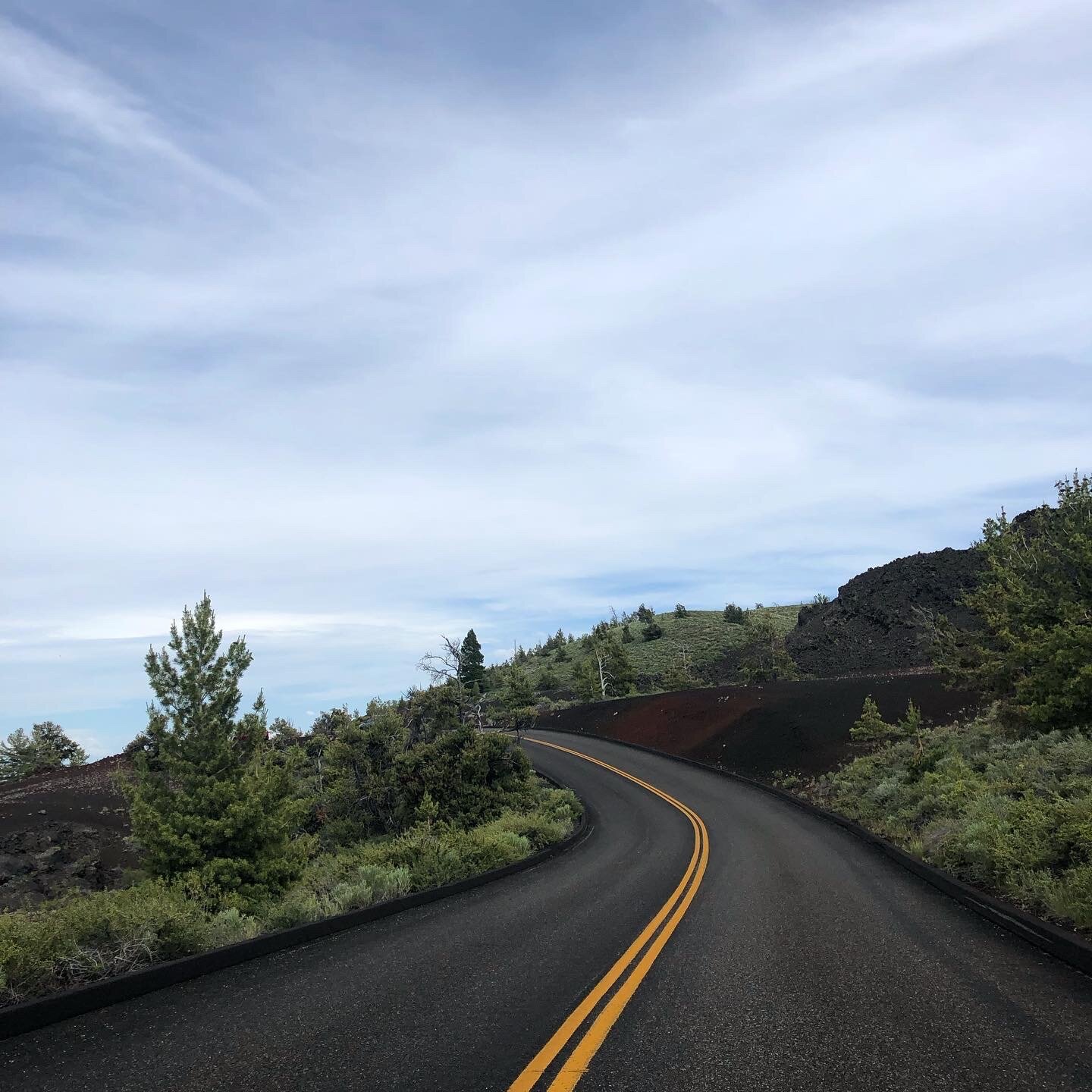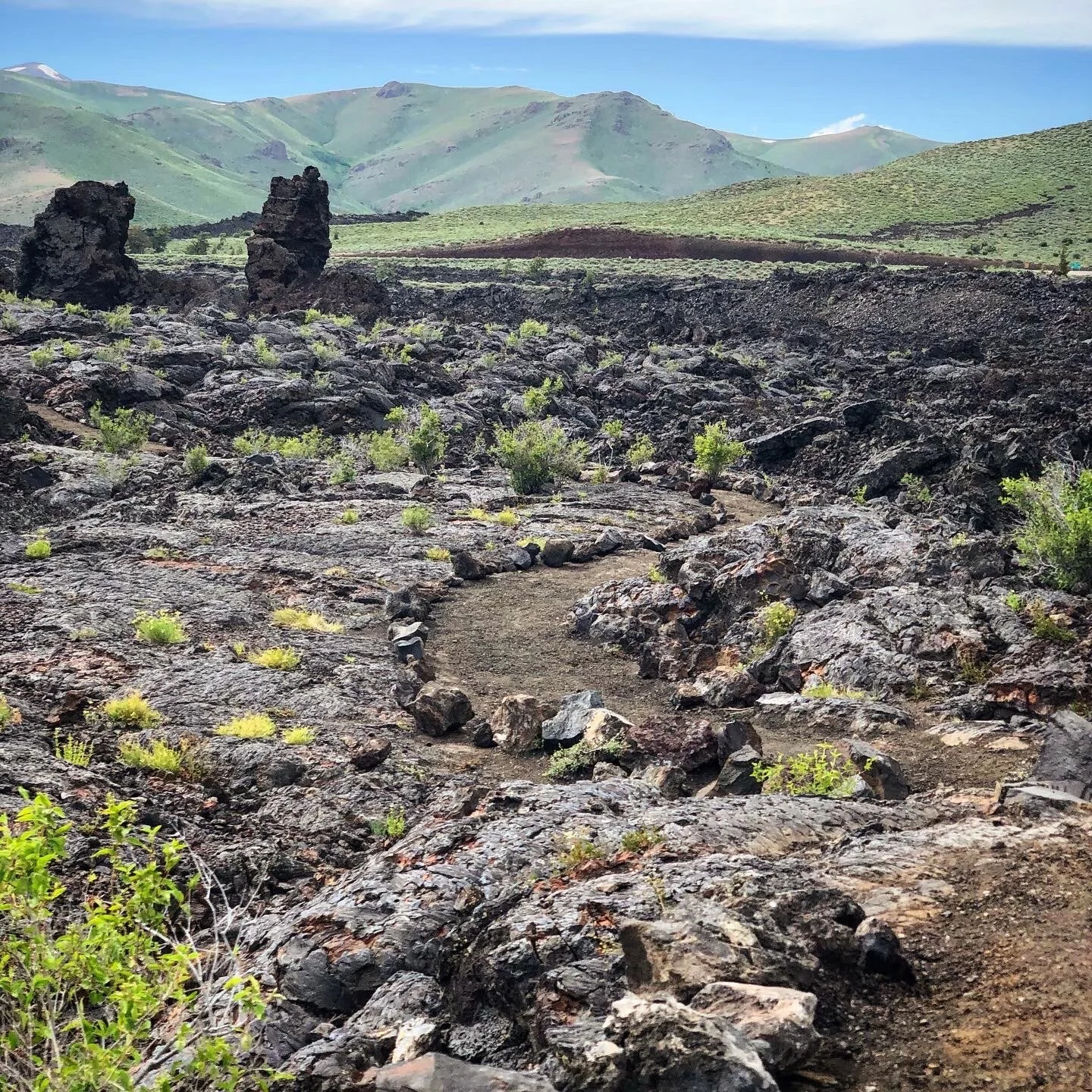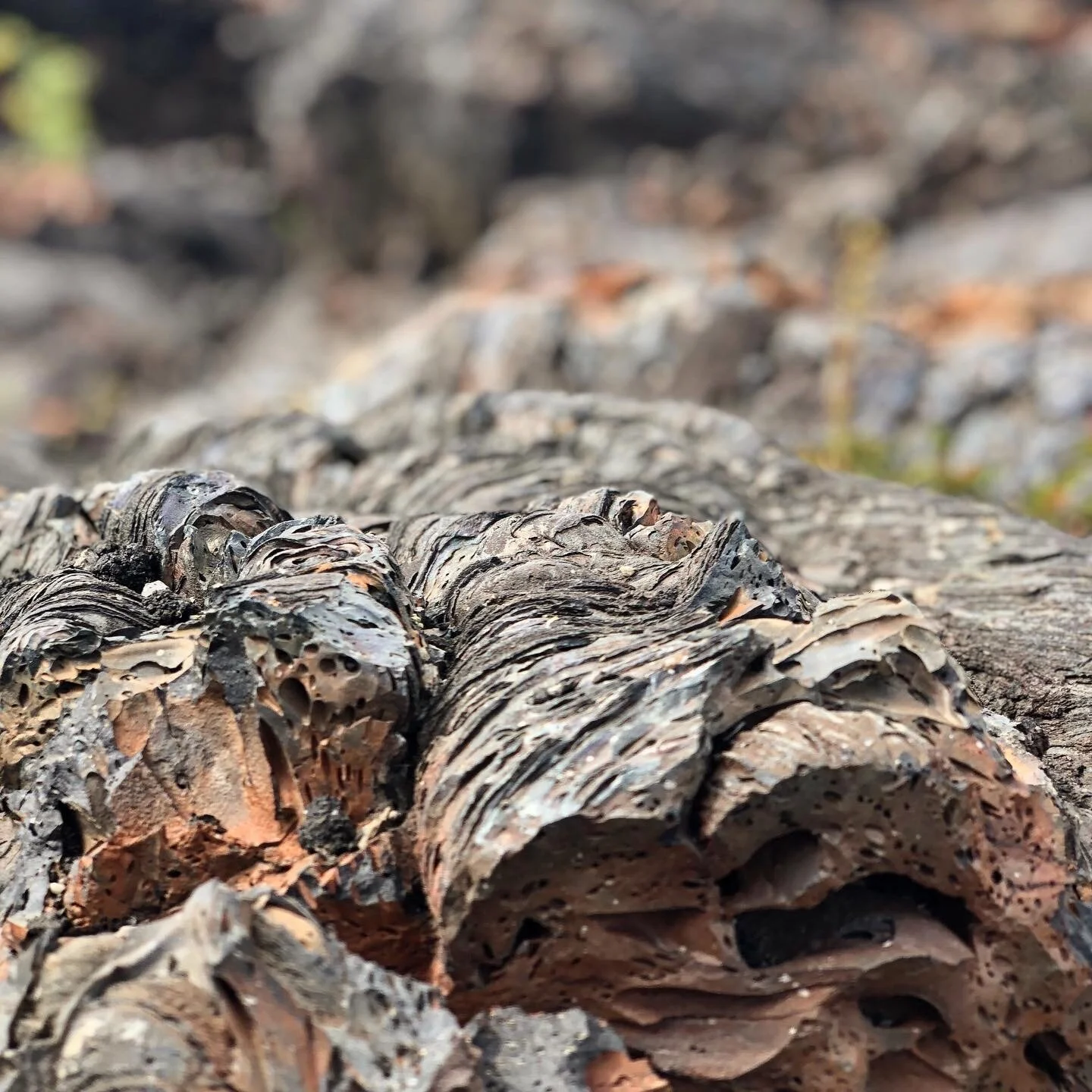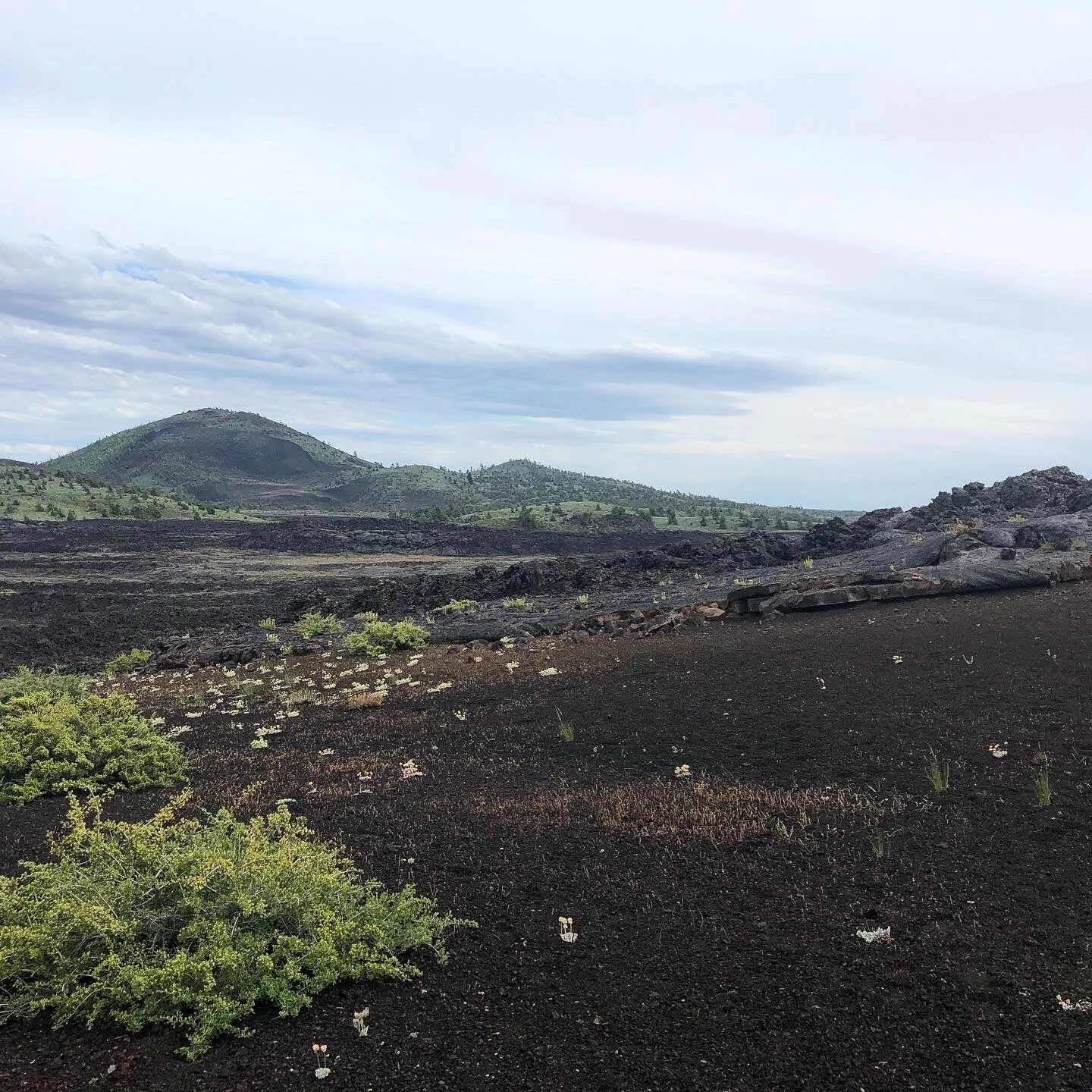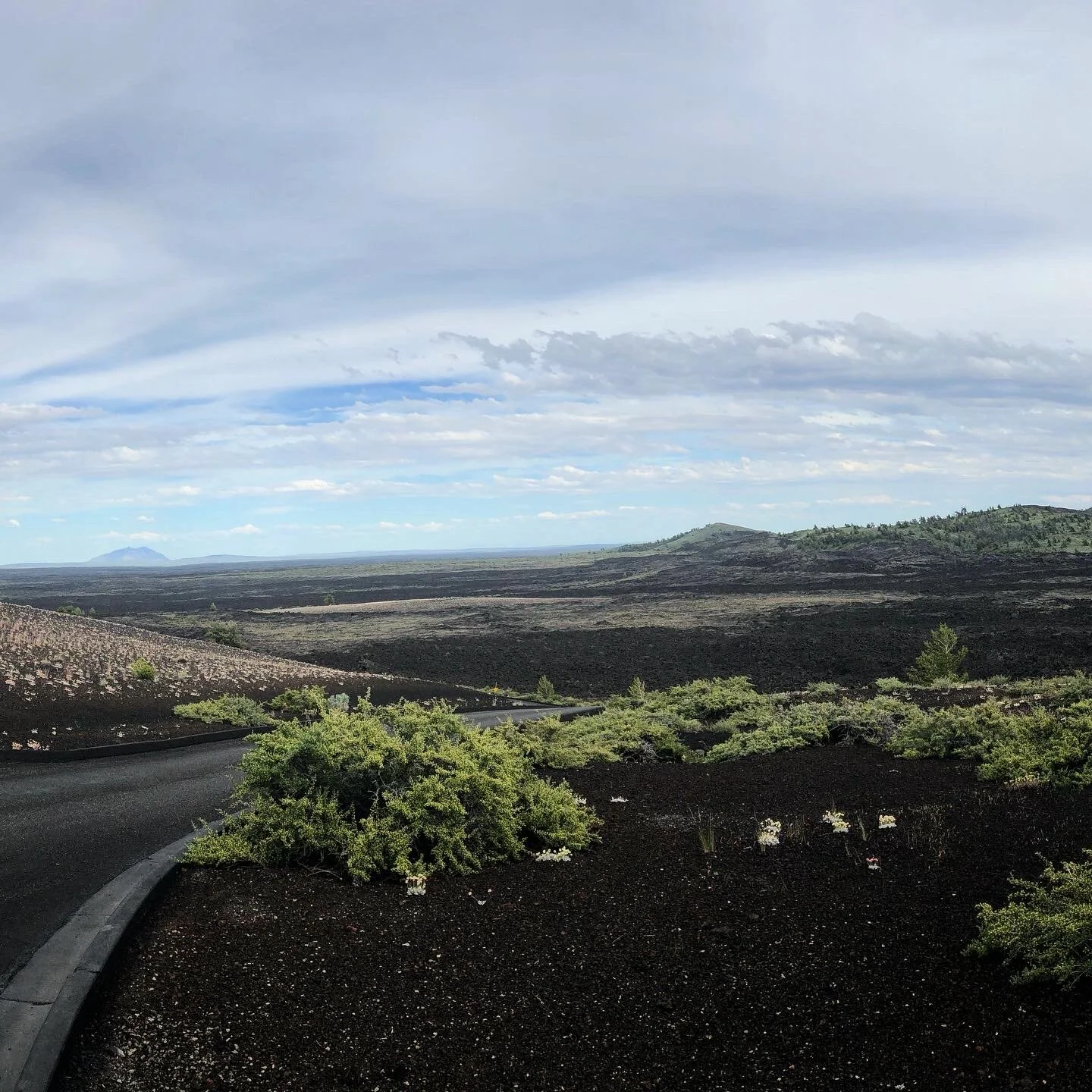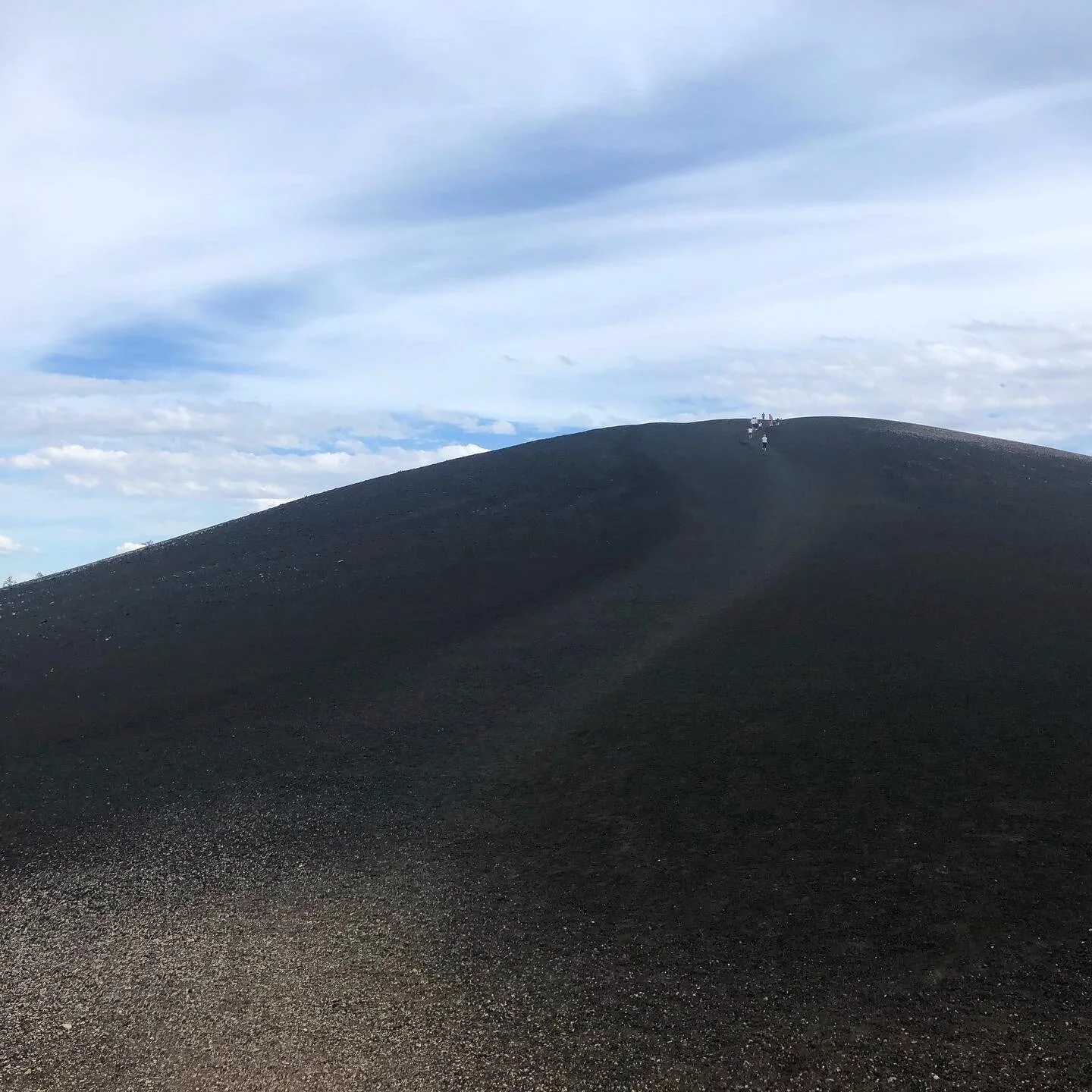Craters of the Moon Lunar Ranger
That’s Snow Cone – made of cinder, not snow. It’s a volcanic spatter cone that once produced fiery fountains up to 1,000 feet high.
This land is an enigma filled with the most bizarre biological features. A geologic jambalaya made up of giant black boulders tower over rock-solid molten lava streams. Accents of deep red, burnt orange, bits of brown, and strokes of blue, paint the alien panorama pictured above. And out of those once fiery rivers, the most delicate, pastel flowers sprout from a seemingly lifeless surface. That's a quick snapshot of Craters of the Moon National Monument & Preserve. It's hard to fully capture what's so special about this place. But when I tell you it's a landscape unlike any I've ever seen, I mean it to the extent that I didn't even know that a place with these colors, shapes, and traits existed.
Every road I've ever set wheels on in Idaho has been beautiful. But the highway you take to get to Craters of the Moon from Boise is particularly picturesque. Along the Peaks to Craters Scenic Byway, you'll see snow-tipped summits zigzagging before a powder blue sky streaked with wispy white clouds. You'll see the mountains gradually fade into a crinkled blanket of browns and greens draped over dune-like hills. And an expansive spread of dense vegetation that rolls unobstructed for miles. Gorgeous scenery, but nothing out of the ordinary. Until suddenly, thick jet black, mulch-like stuff starts appearing in patches over the grass. Those scattered patches of the darkest, chunkiest, almost devils-food-like debris quickly turn into the predominant terrain covering acres of shrubbery in every direction – more than a foot thick. And it comes out of nowhere, after driving through lush green and golden grasslands for hours.
Those rugged black rock features look as though they don't belong, but in a beautiful way. The less grass I started seeing, and the closer I got to "the stuff," the more obvious it became that this was a material, even my inner geologist was completely unfamiliar with. The land's coloring, its characteristics, everything about it was so weird and wonderful.
I cruised along US-20 E mesmerized by the greens and blacks, the flecks of red and shadows of chocolaty brown. When you've lived your whole life on the East Coast, venturing out west will leave your brain unsure that what your eyes are seeing is real. But I've now explored every contiguous state west of Minnesota, and I've never seen anything like Craters of the Moon.
Walking through the parking lot of the visitor center, I heard a mother say to her son, "…and then we'll come back and get your Junior Park Ranger badge!" the little boy jumped and squealed with excitement. He wore weathered hiking boots, a beige bucket hat, and an army green Junior Ranger vest that was already decked in a whole slew of badges. This kid was a well-seasoned national park enthusiast and a child after my own heart. I was dying to get a closer look at his vest to see which parks he'd been to, but I didn't want to be that creepy 30-year-old.
I remembered 103-year-old Rose Torphy, who became the oldest Junior Park Ranger ever, earlier this year at Grand Canyon National Park. What a cool chick. I admire her. I admire every young-at-heart adult who lets their eternal youth get out and walk around. So into the visitor center, I went to learn about this outlandish land, follow in Rose's footsteps and live life like the ball of fire I am.
Right off the bat, I learned that millions of years of volcanic activity created the lava fields I was about to explore. And some eruptions were so explosive, so violent, they blew holes in the Earth's crust called calderas, which have since been buried beneath layers and layers of basalt and time. The youngest caldera was formed 600,000 years ago in Yellowstone National Park. And what's wilder is, these regions are still volcanically active. Geologists predict that Yellowstone will explode again within the next few hundred thousand years, and Craters of the Moon will be due for more volcanic activity within the next thousand years.
After touring the museum, I waited on line to snag my Junior Ranger booklet and a map behind a family of ambitious adventurers – the kind I look up to and wonder if they can sense that I love the parks with the same vigor they do, but at this juncture in my life (and all junctures prior), I am unwilling to embark on a 7.8-mile hike. I might be up for it someday with a special friend, or if someone wanted to bribe me like the time I was 15, and my dad offered to pay me $50 to eat one forkful of steak. But when I'm steering the trip, I like to take the lazy river of hikes and enjoy leisurely scenic drives for easily accessible natural beauty.
So I was pretty much gearing up to ask the cute ranger at the counter exactly that: how many awesome things can I see without doing anything too strenuous. That and can I become a Junior Park Ranger and what the heck is this crazy place, and why aren't there others like it? He happily showed me on my map all of the awesome things I wouldn't want to miss and how some of the features I'd come across were from volcanic eruptions as recent as 2,000 years ago. Wow! What?! He went on to explain that volcanoes have erupted all over the planet, even in places where no hill or mountain is present. Today, we have roughly 1,500 active volcanoes throughout the world, and far more that lie dormant or are extinct.
And then I asked him another tell-me-more question, and I couldn't even begin to tell you what his response was. He was extremely knowledgable, but I think we would've needed index cards, a homemade diorama, some kind of demonstration or a reenactment, lots of visuals, maybe a movie or three, and then maybe, just maybe, my un-science mind would've begun to grasp these explosive concepts.
Sometimes if an explanation feels too sciencey––more commonly known as scientific––my overly dominant right brain kicks in with magic tricks, a round of iSpy, and three songs mashed together into one and usually with many wrong lyrics. For instance, I recently learned that Billy Joel isn't singing, "He works at Mister Cacciatore's down on Sullivan Street, across from the metal placenta." He's actually singing "medical center." Medical center? Not, metal placenta? Are we sure? Yup! Definitely sure! This was news to me. What the hell's a metal placenta anyway?
See how easy it is for me to get sidetracked while on the topic of science? Next thing I know, this sweet ranger was smiling at me, waiting for some hint of recognition that the words he had spoken were English and that I was a humanoid being who understood them. Truth is, I'm fascinated by scientific concepts – I just don't typically retain them with ease. I do better when they're explained in the form of analogies or the simplest, relatable laymen's terms possible.
I decided to respond genuinely, "I'm so sorry, that went right over my head…can you––" "Oh, of course, no problem!" the patient park ranger went on to explain again and I kind of sort of maybe got a piece of it, but not enough for me to break it down here for you today.
Not wanting to take up too much of his time, I, somewhere between shy and gleeful, asked him if I could become a Junior Park Ranger. I don't know why I was slightly timid and nervous to ask. I felt like a third grader asking if she could have two cookies instead of one or extra time at recess. Mr. Ranger's response with the biggest, purest smile was, "Well, of course you can! We'd be honored to have you as one of our Lunar Rangers!" He was so excited, and I was so excited. We're called Lunar Rangers?! That's so perfect! I was already thinking of myself as one of them.
He reached under the counter and pulled out my Lunar Ranger workbook. The first phrases I read were, "Orbit the Monument on the 7-mile loop drive" and "When you finish, report back to Mission Control." Orbit?! Mission Control?! They had me hook, line, and sinker. And Mr. Ranger took me so seriously, but in the most fun way – he went over safety precautions, reminders about staying hydrated, on the trails, and all sunscreened up. And then he got me giddy to embark on this new adventure.
My first stop was Devils Orchard. I was wearing flip-flops, which I fully acknowledged were an even worse choice than stilettos in this particular park, but I kind of wanted to see just how poor a choice they really were, before I went and stuffed my freedom-loving feet into stifling socks and neon-laced sneakers. Even my Lunar Ranger workbook called "protective footwear" mandatory, and I'm certain any ranger would've said my flimsy flops were anything but protective. I took a few baby steps onto the trail and yup––terrible idea. I could feel every bit of basalt biting the bottoms of my feet, so I quickly scurried back to switch out shoes.
All laced up and ready to leave no trace, I began my stroll along the solid magma rivers that once floated massive heaps of crater walls after nearby volcanoes erupted so violently they tore themselves apart 16 million years ago. And the lava fields left behind were so intricate with colorful swirls and twirls, they appeared to be almost artistically designed. It was almost like wandering through the remains of a science experiment gone wrong, but that ended up creating something unusually beautiful and well worth preserving.
On my way to see the Snow cinder cone, my eyes were again in total disbelief. Flowers – beautiful peach, coral, and yellow flowers called Dwarf buckwheat were blooming through a smooth basalt hillside. But don't let the name "Dwarf buckwheat" fool you––they were some of the prettiest little buds I ever did see. And what an unlikely find, growing from a field of frozen lava. How anything could grow through such devastation is mystifying. It reminds me of the lotus flower and how it only grows from mud and how people flourish after falling.
I explored the rest of the monument wondering how the next cataclysm would rearrange the landscape. I searched for animal tracks, lava bombs, bluebirds, and nutcrackers––all possible sightings, according to my Lunar Ranger workbook. Then, once I decoded a secret code, got imaginative and wrote about what the first Intergalactic Park could be, and finished the rest of my workbook and the scenic loop drive, I headed back to Mission Control to get sworn in by the sweet ranger from earlier.
But by the time I got back, their shifts had changed, and an adorable older ranger lady who was running a very tight ship was going to swear me in for my first-ever Junior Park Ranger badge. I watched how she took her time looking over the workbook of the kid in front of me. She asked him to tell her something he'd learned about the park. Crap! Was she going to ask me that? Surely I'd learned a ton, but my mind drew blanks under imaginary pressure. Where am I again? What time zone is this? What park is this? Craters of the Fork? Take it easy, Laur – it's just the first-timer jitters.
After she swore in the nine-year-old in front of me, I was up. I presented my book with a smile. She smiled back, "Ah, an adult Junior Ranger…well let's see what you've got here." She scrutinized my book, still smiling; she asked me to share something I'd learned, then she added to it and taught me even more. Then she had me hold up my right hand, in a Vulcan salute and told me to repeat after her. The pledge went something like, "As a Lunar Ranger, I promise to explore the Earth in order to reach for the stars…take care of Craters of the Moon and other special places, so they will always be here for me and future generations to enjoy." And then I was awarded my very own silver and black Lunar Ranger badge!
I was hooked on the Junior Ranger program and determined to become one at every park. Each NPS site has its own badge, its own pledge, and its own workbook, you know – so it's a completely different, uniquely awesome experience everywhere you go. I highly recommend that everyone becomes a Junior Park Ranger at an NPS site. It's such a fun and original way to explore and learn about our parks and our planet. I also highly recommend exploring Craters of the Moon National Monument. It is the coolest place most people have never heard of, and exploring it is as otherworldly as a walk on the moon.
